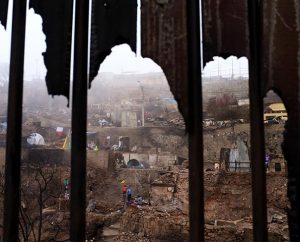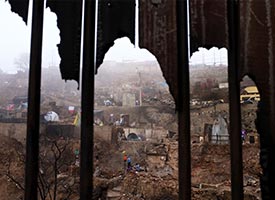By Paula Schlueter Ross
Hurricane Katrina. Superstorm Sandy. Tornadoes in Joplin, Mo., and Moore, Okla. Typhoon in the Philippines. Flooding in Colorado. Mudslides in Washington state. Ebola in Guinea, West Africa. Earthquakes in Japan, Haiti and now Chile. Bombings. Shootings.

These days, it may seem like devastating tragedies are never-ending, sort of a “disaster du jour” environment — with life-changing losses and horrendous human needs laid bare on TV, on the Internet and in newspapers every single day.
But there’s a light in the darkness: Through it all, The Lutheran Church—Missouri Synod and its LCMS Disaster Response are there, “reaching out with caring and compassion in the name of Christ to those who are in need,” notes the Rev. Glenn F. Merritt.
“Nowhere is the body of Christ stronger,” he adds, “than when it touches lives in time for eternity with the Gospel of hope and peace found in Jesus. This is the call of the church!”
Merritt, who is preparing to retire after serving as director of LCMS Disaster Response since 2006, describes the human-care ministry as “the leading edge of the cutting edge among faith-based disaster-response organizations around the world.
“In a unique way, following a truly biblical model,” he says, LCMS Disaster Response “makes available aid and assistance provided by generous donors to local congregations, districts and partner churches as they respond to disaster and tragedy in their own communities.”
There’s perhaps no better time to illustrate that calling than the present, as the ministry continues to provide aid in the wake of catastrophes near and far, both old and new.
Here’s an update on:
- Superstorm Sandy, the hurricane that led to the deaths of more than 280 people in seven countries in October 2012. In the months following the storm, the LCMS provided more than $1.4 million in grants to help those with damages.
Now LCMS Disaster Response is providing another $750,000 over three years to the LCMS Atlantic District to continue relief and recovery efforts in the Far Rockaway area of New York City.
The grant — which is being supplemented by $250,000 from the district — will be used to establish a community center on a busy corner in a depressed area that “looks like the storm was yesterday — the sand is still in the street, the buildings are boarded up, nothing has happened,” said Atlantic District President Rev. Dr. David Benke.
The center — to be staffed by local residents as well as Lutherans — will offer personal, family and crisis counseling; job training and help with finding employment; and spiritual resources such as Bible studies and eventually a worship area.
The church, Benke said, “should be going where the problem is the worst because we have the best solution, and that is, we have the Gospel — we’re going to bring Jesus to them in Word and deed.”
- the May 20, 2013, tornado in Moore, Okla. Within days of the storm, the Synod sent a $100,000 emergency grant to the LCMS Oklahoma District to meet immediate needs of LCMS members and the community.
Another $170,000 also was provided for the 2013-14 school year so that St. John’s Lutheran School in Moore could offer scholarships to area students whose families reported tornado losses as well as to students at an elementary school that was destroyed by the storm.
Additional support from LCMS Disaster Response totaling $340,000 (for the 2014-15 and 2015-16 school years) also is committed to St. John’s for scholarships for families directly affected by the storm.
Also being re-funded, for $40,000, is an eight-week summer camp for some 100 area children.
- the Nov. 8 typhoon in the Philippines, which killed at least 6,000 people and left 4 million displaced. To date, LCMS Disaster Response has provided $528,400 for aid to the Philippines — which is being used to rebuild and repair homes, provide food and restore livelihoods. That total includes $228,400 to Orphan Grain Train this year to purchase and ship containers of rice and vegetables that will provide some 676,000 meals to residents of the hard-hit island of Leyte.
Before the meals are distributed in various Leyte sites, members of the Lutheran Church in the Philippines (LCP) will lead prayers acknowledging “that these are gifts that come from the Lord,” notes the Rev. Ross Johnson, who is serving alongside of — and will succeed — Merritt July 1 as director of LCMS Disaster Response. “And they do it in the name of the Lutheran church, so that the people see that Lutherans are engaged in the needs of their communities, [that] they are acting mercifully.”
From March 17 to 21, Johnson and Merritt helped lead an “Aftercare Retreat” in Palawan, the Philippines, for LCP leaders, disaster-relief teams and their families who “had been directly affected by [the typhoon] or who had been directly engaged with the relief and recovery efforts,” according to Merritt.
“The central focus of the retreat was keeping Christ at the center of our lives during stressful and trying times,” he explained, particularly since the Lutheran leaders “were becoming overwhelmed as they continued to minister to those in need.”
The “time of renewal and reflection” — which addressed topics such as stress management, ministry in the aftermath of tragedy and “mercy as a way of life that leads to a powerful witness of the Gospel and Christ” — was “well-received overall, with many words of thanks and gratefulness,” Merritt told Reporter.
To watch a new video about how LCMS and Philippine Lutherans are responding to the needs of typhoon victims, “Typhoon Haiyan Update: Restoring Joy in the Philippines,” visit lcms.org/video/philippinesrecovery.
- the March 22 mudslide in Oso, Wash., which killed at least 41 people and damaged some three dozen homes. Johnson and colleague the Rev. Michael Meyer, manager of LCMS Disaster Response, visited Oso and area Lutherans March 30-April 1.
As a result of that visit, the ministry plans to send trained emergency-services chaplains to provide counseling and other support to local firemen, policemen and those involved in the search for mudslide victims.
“They are emotionally and physically exhausted,” Johnson explained. “Their health is deteriorating and many of them are worn out. So chaplains are absolutely needed to aid and give mercy to these first responders.”
Meyer recalled being at the Red Cross shelter when the incident commander came by to give an update to families who were worried about their missing loved ones.
“We could tell that it was really affecting him because he started to break down a couple of times,” Meyer said. “And that highlighted for us the need that is there regarding these first responders and the specialized care that it’s going to take to help not just debrief them but to help give them strength for each new day.”
The LCMS chaplains — who are on “stand-by,” ready to depart for Oso as soon as local authorities there give the go-ahead — will likely minister to many non-Lutherans and unchurched people, noted Johnson: “It’s our opportunity to bring Christ and the message of peace that only the Gospel gives to a world that is broken and dying in front of them.”
- the Ebola virus outbreak in Guinea, West Africa. At the request of the Rev. Felix Mamadouno, president of the Evangelical Lutheran Church of Guinea, LCMS Disaster Response sent on April 3 a $6,554 emergency grant to the church body that will be used to purchase health kits to prevent and treat the deadly disease.
Merritt said the kits include “sanitation and rehydration items that bring some relief.” There is no cure for Ebola, which is spread through bodily fluids and the handling of infected corpses.
At this writing, Guinea had reported 109 confirmed cases of the Ebola virus, with 61 resulting in death, according to news reports.
- the April 1 earthquake and mid-April wildfires in Chile, South America. At press time, an LCMS Disaster Response team was in Chile April 20-27 to visit the sites of both tragedies — Iquique and Valparaiso, respectively — and discuss needs with leaders of the Confessional Lutheran Church of Chile, an LCMS partner church.
More than 2,500 homes sustained serious damage in the earthquake, and some 11,000 are homeless as a result of the wildfires, according to news reports.
In addition to assisting victims in the aftermath of calamities worldwide, LCMS Disaster Response also provides training to help others serve as “the hands and feet of Christ.”
Here are two examples:
- Lutheran Early Response Team (LERT) training. At these events — which take place at least a dozen times a year — LCMS Disaster Response staff and LERT trainers in each of the Synod’s 35 districts teach the fundamentals of disaster response to congregational leaders.
A training event on March 29 at St. John’s Lutheran Church in East Moline, Ill., for example, drew some 60 participants from a half-dozen area congregations. Meyer, who led that session, said the training addresses what LCMS Disaster Response does, why the church needs to respond in times of disaster, how congregations can prepare before disaster strikes and what disaster volunteers might do to help in the wake of a disaster.
- disaster manuals for church workers. The 70-plus-page manuals written for educators and pastors are designed for use before and during times of natural and man-made disasters, offering tips for preparation and ideas for how to respond.
Brand-new for those who serve schools is Mercy in Action: A Guide for Educators in the Midst of Disaster, which will be distributed by LCMS Disaster Response staff at LCMS educators conferences beginning this month.
The updated Mercy in Action: A Guide for Pastors in the Midst of Disaster, which is designed for congregations, is expected to be completed this summer.
Both resources are free and will be available in print form only. Says Johnson: “The goal is that in a time of disaster [educators and pastors] would have the manual in their hands.”
Also in the process of being updated is the LERT training manual, which will likely be available, also free, by year’s end.
For more information about the manuals, send an email to disaster@lcms.org.
Johnson describes the Synod’s response to disaster as “multi-faceted — whether it’s man-made, natural or humanitarian, we, as members of The Lutheran Church—Missouri Synod, look for opportunities to be the light of Christ in a dark world. And to be a blessing to the world around us that is hurting.”
That care, he stresses, is for everyone. “The care and the mercy and the concern that we have isn’t only for Lutherans. It’s definitely also for other Christians and for the nonbelieving world.”
For more information about LCMS Disaster Response — including how to make a gift to support the Synod’s relief and recovery efforts — visit lcms.org/disaster.
Posted April 28, 2014

